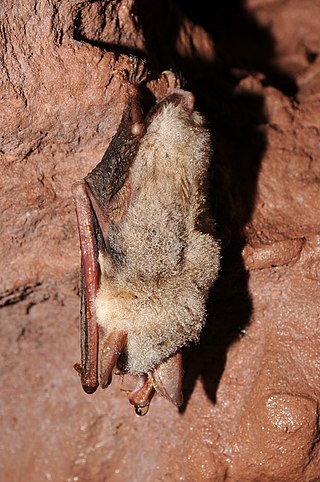
Vespertilionidae is a family of microbats, of the order Chiroptera, flying, insect-eating mammals variously described as the common, vesper, or simple nosed bats. The vespertilionid family is the most diverse and widely distributed of bat families, specialised in many forms to occupy a range of habitats and ecological circumstances, and it is frequently observed or the subject of research. The facial features of the species are often simple, as they mainly rely on vocally emitted echolocation. The tails of the species are enclosed by the lower flight membranes between the legs. Over 300 species are distributed all over the world, on every continent except Antarctica. It owes its name to the genus Vespertilio, which takes its name from a word for bat, vespertilio, derived from the Latin term vesper meaning 'evening'; they are termed "evening bats" and were once referred to as "evening birds".

Paraponera clavata, commonly known as the bullet ant, is a species of ant known for its extremely painful sting. It inhabits humid lowland rainforests in Central and South America.
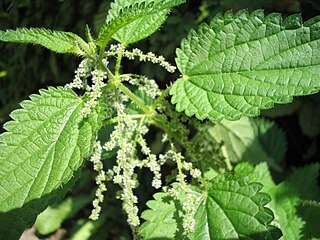
The Urticaceae are a family, the nettle family, of flowering plants. The family name comes from the genus Urtica. The Urticaceae include a number of well-known and useful plants, including nettles in the genus Urtica, ramie, māmaki, and ajlai.

Fire ants are several species of ants in the genus Solenopsis, which includes over 200 species. Solenopsis are stinging ants, and most of their common names reflect this, for example, ginger ants and tropical fire ants. Many of the names shared by this genus are often used interchangeably to refer to other species of ant, such as the term red ant, mostly because of their similar coloration despite not being in the genus Solenopsis. Both Myrmica rubra and Pogonomyrmex barbatus are common examples of non-Solenopsis ants being termed red ants.

Plantaginaceae, the plantain family, is a large, diverse family of flowering plants in the order Lamiales that includes common flowers such as snapdragon and foxglove. It is unrelated to the banana-like fruit also called "plantain." In older classifications, Plantaginaceae was the only family of the order Plantaginales, but numerous phylogenetic studies, summarized by the Angiosperm Phylogeny Group, have demonstrated that this taxon should be included within Lamiales.

Myrmecia is a genus of ants first established by Danish zoologist Johan Christian Fabricius in 1804. The genus is a member of the subfamily Myrmeciinae of the family Formicidae. Myrmecia is a large genus of ants, comprising at least 93 species that are found throughout Australia and its coastal islands, while a single species is only known from New Caledonia. One species has been introduced out of its natural distribution and was found in New Zealand in 1940, but the ant was last seen in 1981. These ants are commonly known as bull ants, bulldog ants or jack jumper ants, and are also associated with many other common names. They are characterized by their extreme aggressiveness, ferocity, and painful stings. Some species are known for the jumping behavior they exhibit when agitated.

Myrmeciinae is a subfamily of the Formicidae, ants once found worldwide but now restricted to Australia and New Caledonia. This subfamily is one of several ant subfamilies which possess gamergates, female worker ants which are able to mate and reproduce, thus sustaining the colony after the loss of the queen. The Myrmeciinae subfamily was formerly composed of only one genus, Myrmecia, but the subfamily was redescribed by Ward & Brady in 2003 to include two tribes and four genera. An additional three genera, one form genus, and 9 species were described in 2006 from the Early Eocene of Denmark, Canada, and Washington. Subsequently an additional fossil genus was moved from the family Rhopalosomatidae in 2018, and a new genus was described in 2021.

Adetomyrma venatrix, more commonly known as the Dracula ant, so named because of its grisly feeding habits of drinking the blood of its young, is an endangered species of ants endemic to Madagascar. Workers of this species are blind. The species was described as the type species of Adetomyrma in 1994, with the genus being an atypical member of its tribe.
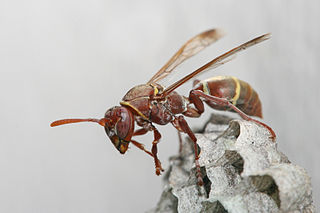
The Polistinae is a subfamily of eusocial wasps belonging to the family Vespidae. They are closely related to the wasps and true hornets of the subfamily Vespinae, containing four tribes. With about 1,100 species total, it is the second-most diverse subfamily within the Vespidae, and while most species are tropical or subtropical, they include some of the most frequently encountered large wasps in temperate regions.

Phengaris rebeli, common name mountain Alcon blue, is a species of butterfly in the family Lycaenidae. It was first found and described in Styria, Austria, on Mount Hochschwab around 1700. Although it was initially classified as a subspecies of P. alcon, a European researcher, Lucien A. Berger, designated it as a separate species in 1946. Genetic similarities between P. rebeli and P. alcon have led many researchers to argue that the two are the same species and differences are due to intraspecific variation.

Monomorium is a genus of ants in the subfamily Myrmicinae. As of 2013 it contains about 396 species. It is distributed around the world, with many species native to the Old World tropics. It is considered to be "one of the more important groups of ants," considering its widespread distribution, its diversity, and its variety of morphological and biological characteristics. It also includes several familiar pest species, such as the pharaoh ant and the flower ant.
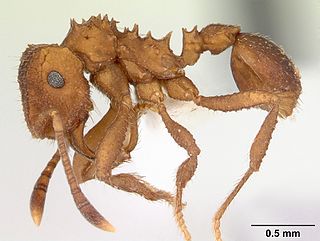
Mycocepurus is a Neotropical genus of fungus-growing ants in the subfamily Myrmicinae. The genus is known from Mexico, south to Brazil and Argentina. Like other attines, they primarily grow fungi of the tribe Leucocoprini. They use many different substrates for growing their fungi, from dry leaves and caterpillar dung to fruit matter. One of its species, Mycocepurus smithii, which lives in South America, reproduces by cloning – all ants in a colony are clones of the queen. M. castrator is a parasite of M. goeldii.

Prionomyrmex is an extinct genus of bulldog ants in the subfamily Myrmeciinae of the family Formicidae. It was first described by Gustav Mayr in 1868, after he collected a holotype worker of P. longiceps in Baltic amber. Three species are currently described, characterised by their long mandibles, slender bodies and large size. These ants are known from the Eocene and Late Oligocene, with fossil specimens only found around Europe. It is suggested that these ants preferred to live in jungles, with one species assumed to be an arboreal nesting species. These ants had a powerful stinger that was used to subdue prey. In 2000, it was suggested by Cesare Baroni Urbani that the living species Nothomyrmecia macrops and a species he described both belonged to Prionomyrmex, but this proposal has not been widely accepted by the entomological community. Instead, scientists still classify the two genera distinctive from each other, making Nothomyrmecia a valid genus.

Silvanidae, "silvan flat bark beetles", is a family of beetles in the superfamily Cucujoidea, consisting of 68 described genera and about 500 described species. The family is represented on all continents except Antarctica, and is most diverse at both the generic and species levels in the Old World tropics.

Atta cephalotes is a species of leafcutter ant in the tribe Attini. A single colony of ants can contain up to 5 million members, and each colony has one queen that can live more than 20 years. The colony comprises different castes, known as "task partitioning", and each caste has a different job to do.
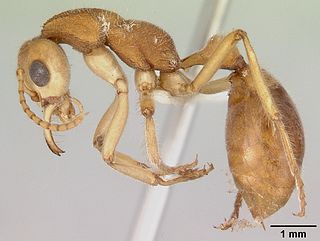
Prionomyrmecini is an ant tribe belonging to the subfamily Myrmeciinae established by William Morton Wheeler in 1915. Two members are a part of this tribe, the extant Nothomyrmecia and the extinct Prionomyrmex. The tribe was once considered a subfamily due to the similarities between Nothomyrmecia and Prionomyrmex, but such reclassification was not widely accepted by the scientific community. These ants can be identified by their long slender bodies, powerful stingers and elongated mandibles. Fossil Prionomyrmecini ants were once found throughout Europe, possibly nesting in trees and preferring jungle habitats. Today, Prionomyrmecini is only found in Australia, preferring old-growth mallee woodland surrounded by Eucalyptus trees. Nothomyrmecia workers feed on nectar and arthropods, using their compound eyes for prey and navigational purposes. Owing to their primitive nature, they do not recruit others to food sources or create pheromone trails. Nothomyrmecia colonies are small, consisting of 50 to 100 individuals.

Eulithomyrmex is an extinct genus of ant in the formicid subfamily Agroecomyrmecinae. The genus contains two described species, Eulithomyrmex rugosus and Eulithomyrmex striatus. Eulithomyrmex is known from a group of Late Eocene fossils which were found in North America.

Ochetellus is a genus of ants first described by Steve Shattuck in 1992. He placed it in the subfamily Dolichoderinae of the family Formicidae. The ants in this genus are small and black in colour; workers measure 1.75 to 3 millimetres in length, the males at around 1.6 millimetres (0.06 in) are smaller, and the queens are the largest, reaching 4 millimetres (0.16 in). There are seven described species and three described subspecies that mostly live in Australia in a wide variety of habitats, but some species are found in Asia. One species, Ochetellus glaber, has been introduced into New Zealand and the United States.
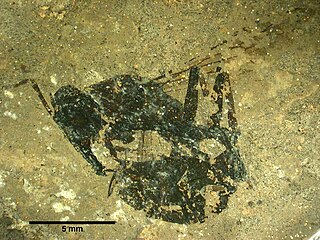
Archimyrmex is an extinct genus of ant in the formicid subfamily Myrmeciinae, described by palaeoentomologist Theodore Cockerell in 1923. The genus contains four described species, Archimyrmex rostratus, Archimyrmex piatnitzkyi, Archimyrmex smekali and Archimyrmex wedmannae. Archimyrmex is known from a group of Middle Eocene fossils which were found in North America, South America, and Europe. The genus was initially placed in the subfamily Ponerinae, but it was later placed in Myrmeciinae; it is now believed to be the ancestor of the extant primitive genus Myrmecia from Australia. Despite this, Archimyrmex is not a member to any tribe and is regarded as incertae sedis within Myrmeciinae. However, some authors believe Archimyrmex should be assigned as incertae sedis within Formicidae. These ants can be characterised by their large mandibles and body length, ranging from 13.2 to 30 mm. They also have long, thin legs and an elongated mesosoma (thorax) and petiole.


















